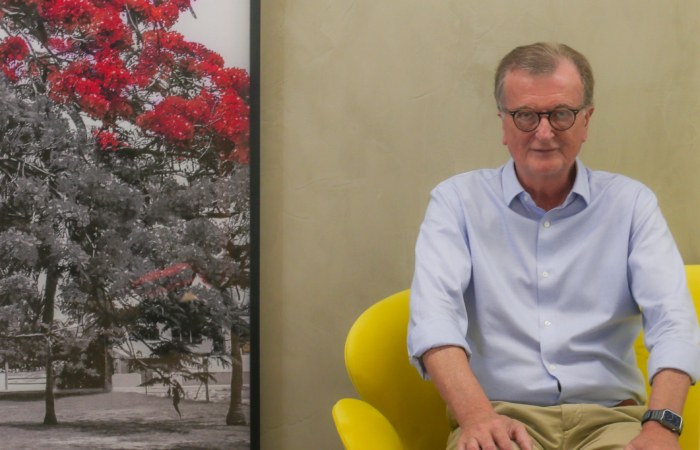In a corporate environment that is increasingly exposed, connected and sensitive to the performance of its leaders, media training assumes a central role in managing corporate reputation. Today, the spokesperson represents his company full-time – not only in front of the press, but also on social networks, forums, events, podcasts, videocasts and other spaces of public visibility.
More than preparing executives for interviews and other forms of presentation to different audiences, the media training must offer a broad approach that considers multiple communication channels and different positioning demands. Training develops essential skills so that leaders can express themselves clearly, coherently and confidently, always aligned with the organization's values and strategic objectives.
By investing in the qualification of their spokespersons, companies strengthen trust with strategic audiences, increase their legitimacy before society and position themselves more solidly in the face of reputational opportunities or challenges.
In this guide produced by experts at ANK Reputation, you will learn the main techniques used in media training in companies. You will also understand the importance of this type of learning for managing a company's reputation, as well as valuable tips for effective institutional communication.
Read: Successful mentoring contributes to the reputation of companies and leaders
What is media training?
Media training, as the expression in English says, is a specialized training that prepares leaders and spokespersons for communication in public visibility spaces, such as: press, podcasts and videocasts, different types of video recording, lectures and talks, among others. The goal is not just to “teach how to speak well”. The focus is on enhancing verbal and non-verbal communication techniques, personal presentation, in addition to aligning the speech with the company's strategy, protecting the reputation and transforming each appearance into an opportunity to strengthen the institutional image.
Media training aims to equip spokespersons with the tools they need to effectively communicate the organization’s vision, values, and messages, even under pressure or in challenging situations. The goal is to ensure that interactions with the media and other strategic audiences are opportunities to strengthen the company’s image, build trust with stakeholders, and positively influence public opinion.
It is important to remember that an interview is not an informal conversation – nor are other public statements. Well-prepared spokespersons avoid noise, convey confidence and defend the institutional narrative. A well-prepared executive conveys confidence, clarity and control of the situation, reflecting positively on the company's image. Every public appearance is a chance to create value – or a way to destroy it.
Media training in practice: how is the training done?
Media training activities prepare leaders and spokespersons to take public positions on strategic business issues in different situations. The goal is to ensure that the corporate narrative is consistent and aligned across all communications, reinforcing the organization's values, mission and objectives.
Training includes theory and practice. Participants receive up-to-date information on the context of newsrooms, how the press and digital channels work in general, verbal and non-verbal language, corporate storytelling, crisis management, simulated interviews with feedback and preparation for difficult questions. The program can last from a few hours to several sessions, depending on the professional's challenge and the format chosen.
Simulations may involve participation in television, radio, online media, podcasts and videocasts, and print media. Content is delivered through interactive workshops, analysis of real-life cases, development of key messages, and techniques for managing difficult questions and sensitive communications. Sessions can be individual or group, tailored to the needs and experience level of participants. Tools such as recordings and constructive feedback are often used to enhance the performance of spokespersons.
Media training uses different techniques to prepare leaders and spokespersons for strategic interactions with the press and the general public.
In simulations, participants go through simulated interviews with journalists, facing challenging questions and situations to learn how to structure strategic responses.
Simulated interviews and different public appearances are an essential part of media training, helping leaders and spokespeople prepare for real interactions.
Training can include an influence map, an instrument to identify strategic audiences and the main themes of the leader's communication, allowing for more assertive and focused preparation.
5 most commonly used public performance simulation techniques in training
- Demonstrations in the face of corporate image crisis: The spokesperson is placed in a fictitious scenario where the company is facing an image crisis. The goal is to practice strategic responses to different stakeholders, avoid statements that could worsen the situation and demonstrate transparency and control.
- Mock press conference: Executives participate in a simulated press conference, in which journalists ask questions about a product launch or a strategic change in the company, for example. The training focuses on the clarity of messages and management of speaking time.
- Surprise interview: The leader is approached without warning and has to answer unexpected questions about strategic business issues. This type of exercise improves improvisation skills and emotional control.
- Debate on controversial topics: The spokesperson is trained to deal with sensitive issues such as ESG, diversity or industry regulations. The goal is to ensure that the company’s narrative is well positioned and aligned with institutional values.
- Simulation of different public performances: The executive is recorded in different exposure situations, ranging from radio and television interviews to participation in panels, seminars, podcasts and videocasts. Afterwards, he or she receives feedback on posture, body language and clarity of communication.
Other techniques applied in media training in companies
- Body language analysis
Techniques to improve posture, gestures and facial expressions, ensuring confident and persuasive communication.
- Key Message Mapping
Definition of essential points that must be transmitted in any interaction with the media, avoiding noise in communication.
- Response techniques
They involve methods such as:- “Flag” – Highlight key messages.
- “Hook” – Use strategic snippets to expand answers and
- “Bridge” – Redirect questions to favorable topics.
- Crisis management
Training to deal with critical situations, avoiding statements that could compromise the company's reputation. - Verbal expression and intonation
Developing clarity of speech, appropriate rhythm and using examples to make communication more engaging.
Who runs media training programs?
Media training programs are generally developed by communications consultants, press offices, specialized agencies and journalists with experience in corporate training. It is important that professionals have experience in journalistic writing and a broad understanding of how a media ecosystem works.
Communications consultancy plays an important role in preparing executives before interviews or public events. This preparation always involves defining key messages, anticipating difficult questions, reviewing relevant information and practicing scenarios.
How long does training take in a company?
Training time varies depending on the needs of the company or leaders or the level of depth desired. The program can last a few hours or be divided into continuous blocks.
Introductory sessions can last a few hours, while more comprehensive programs that include specific modules and individual coaching can span days or weeks. Frequency is also important, with periodic refreshers recommended to keep skills fresh.
Reputation Management: Why Train Leaders and Spokespeople
Media training is part of a broader spokesperson development plan, with training to ensure that leaders are prepared for the most common public exposure situations. The goal, in all cases, is to align the corporate narrative and maximize the value of each communication opportunity. Other areas with which media training connects are:
- Digital positioning for leaders: Preparation for strategic action on social networks, such as LinkedIn.
- Mentoring in assertive communication: Development of influence and empathy skills.
- Risk and crisis training: Preparation for sensitive situations that require fast and accurate communication.
Well-done communication generates engagement, trust, credibility, influence and protagonism – which ultimately results. How can we improve? One way is through more persuasive, impactful communication, which is fueled by specialized techniques and soft skills.
Effective communication can build trust, generate influence, strengthen the brand and mitigate damage in potential reputational crises. Communication failures tend to generate distrust, make the reputation more vulnerable and even impact the market value of the organization. Therefore, media training is an essential tool to protect and strengthen all these intangible assets.
For C-level leaders, media training and a robust spokesperson training plan are far from just a cost. They are strategic investments in protecting and growing the reputation of the company and its own leadership. In a world where communication is instantaneous and transparency is so valued, the ability of leaders to communicate clearly, confidently and strategically is a key competitive differentiator.
8 different types of training in institutional communication
The right training makes all the difference in building an institutional reputation. Check out eight types of corporate communication training, designed to prepare executives for different strategic situations and real day-to-day challenges:
- Spokesperson development: Training process that involves technical, emotional and strategic preparation, qualifying executives for institutional representation and public speaking in different situations.
- Media training: Preparation for interviews and interactions with journalists and influencers, focusing on strategic communication, clarity of positioning, focus, security, using key messages, preparation for difficult questions and time control.
- CPI training: Specialized training in dealing with parliamentary investigations and public hearings, preparing the spokesperson for a high-pressure and scrutinized environment.
- Digital positioning for leaders: Strategies to build and maintain a professional and influential online presence, aligned with the company's objectives, seeking reputation, authority and engagement.
- Reputational risk management and image crisis: Preparation to communicate in impactful situations, with quick and efficient responses, seeking to minimize damage to reputation and conveying confidence.
- Communicative leader: Development of the leader's communication skills as the main agent of influence and inspiration, both interpersonally and in public, to engage teams, stakeholders and society.
- ESG Agenda for Spokespersons: Training to communicate, in an authentic and transparent way, the company's environmental, social and governance initiatives, repertoire on contemporary topics and attention to inclusive communication.
- Mentoring for assertive and engaging communication: Individualized support to work on empathy, improve communication skills, for clarity, objectivity, security, power of persuasion and communicational leadership.
Discover ANK Reputation's mentoring and training programs
5 benefits of media training methods
Mastering communication with different audiences, including the media, is essential for any leader who wants to protect and strengthen their reputation and that of their company. In-person media training offers in-depth learning, with live feedback and realistic simulations. See five benefits of this method that goes far beyond theory, preparing executives to face interviews, difficult questions and crisis situations, as well as convey messages with confidence and impact in all their public speeches.
- Personalized and immersive training: Face-to-face interaction allows for immediate adjustments and detailed feedback, ensuring that spokespersons hone their communication skills more effectively.
- Building trust: Practicing in real-world settings, such as mock interviews and press conferences, helps leaders feel more confident when dealing with journalists and key audiences.
- Body language improvement: In-person training allows specialists to correct posture, gestures and facial expressions, ensuring more persuasive communication aligned with the company's message.
- Real-time crisis management: In-person simulations of critical situations help executives develop strategic responses and maintain emotional control under pressure.
- Strengthening the institutional narrative: The training emphasizes building key messages and storytelling, ensuring that spokespeople convey the company's vision and values in a clear, inspiring and impactful way.
Tips for effective communication
From breathing to eye contact with interlocutors, some precautions are essential for effective communication. Check out some of them:
- Body expression when well worked, help speech performance. It is important to be aware, for example, of excessive gestures or habits such as putting your hands in your pockets.
- Breathing, tone and rhythm They also influence the understanding and attention of the interlocutor. Always use different tones and take short pauses in sections that need to be emphasized.
- Connection with the interlocutor is essential. An important gesture is to maintain frequent and natural eye contact with the person you are interacting with.
- Always prefer direct sentences, contextualizing without beating around the bush, exemplifying with facts and data and translating in a practical way. Long sentences make it difficult to maintain focus on the main message and more easily distract the interlocutor's attention.
Speech therapist support may be indicated
In media training, a speech therapist may be needed to prepare a spokesperson or professional who needs to communicate with the press and the public. Some of the main contributions of this specialty may include:
- Voice and diction improvement: The speech therapist works to improve speech clarity, articulation and voice projection, ensuring that the message is understood effortlessly by the audience.
- Breathing control: Breathing techniques help to avoid voice failures and maintain an adequate rhythm when speaking, especially in pressure situations.
- Verbal and non-verbal expression: In addition to speech, the specialist can provide guidance on posture, gestures and facial expressions, strengthening communication and making it more effective.
- Adaptation to the public and the environment: The speech therapist can help the executive adjust their tone of voice and way of speaking depending on the channel – TV, radio, podcasts, for example – and the type of audience.
- Emotion management: The voice can be affected by nervousness or anxiety. The speech therapist teaches strategies to maintain a balanced and confident tone, even when faced with difficult questions.
Conclusion
Rapid changes in communication mean that media training, as part of a broader spokesperson training program, now goes far beyond media relations. Increasingly, media training also involves direct communication with all stakeholders in a variety of situations.
Therefore, reputation management has become inseparable from the preparation of leaders and spokespersons to act in spaces of public visibility such as: press, podcasts and videocasts, different forms of video recording, lectures and panel performances, interactions with the internal public, among others. The objective is to ensure a consistent and aligned corporate narrative in all communications, always seeking to reinforce the values, mission and objectives of the organization.
Check out more about training and media training at https://ankreputation.com.br/formacao-e-desenvolvimento-ank/



